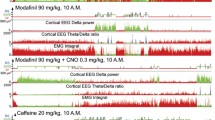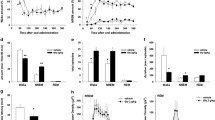Abstract
A prominent hypothesis, the “flip–flop switch” model, predicts that histaminergic (HAergic) neurons in the tuberomammillary nucleus (TMN), an important component of the ascending arousal system, are inactivated by GABA mainly from the ventrolateral preoptic nucleus to allow the appearance and maintenance of sleep. However, which sleep state and the band of EEG activity induced by GABAergic inactivation of the TMN are unclear. In this study, alterations of sleep-wake states and cortical EEG power spectral density were investigated following muscimol, a GABAA-receptor agonist, microinjected bilaterally into the TMN in freely moving rats and HA pretreated rats, respectively. Muscimol dosed at 0.25 and 0.50 μg/side into the TMN during dark period dose-dependently increased slow wave sleep (SWS) accompanied by an increase in cortical EEG delta (0.5–4 Hz) and spindle (8.2–12 Hz) activities. In the meanwhile, wakefulness and EEG beta (12.2–30 Hz) activity were decreased significantly, while paradoxical sleep and EEG theta (4.2–8 Hz) activity were not changed. The increase of muscimol-induced SWS was because of prolonged SWS bout duration and not to an increased bout number. Muscimol (0.50 μg/side) administration 2 h after HA (0.125 μg/side) treatment during light period reversed the HA-induced wakefulness and EEG beta 2 (20.2–30 Hz) activity into SWS and EEG delta activity. These results demonstrate that the GABAergic inactivation of the TMN in freely moving rats and HA-treated rats promotes SWS and slow activity of cortical EEG, suggesting that the potential function of the GABAA receptor in the TMN is to dampen vigilant arousal.






Similar content being viewed by others
References
Haas HL, Sergeeva OA, Selbach O (2008) Histamine in the nervous system. Physiol Rev 88(3):1183–1241. doi:10.1152/physrev.00043.2007
Haas H, Panula P (2003) The role of histamine and the tuberomamillary nucleus in the nervous system. Nat Rev Neurosci 4(2):121–130. doi:10.1038/nrn1034
Lu J, Greco MA, Shiromani P, Saper CB (2000) Effect of lesions of the ventrolateral preoptic nucleus on NREM and REM sleep. J Neurosci 20(10):3830–3842
Lin JS, Hou Y, Sakai K, Jouvet M (1996) Histaminergic descending inputs to the mesopontine tegmentum and their role in the control of cortical activation and wakefulness in the cat. J Neurosci 16(4):1523–1537
Takahashi K, Lin JS, Sakai K (2006) Neuronal activity of histaminergic tuberomammillary neurons during wake-sleep states in the mouse. J Neurosci 26(40):10292–10298. doi:10.1523/jneurosci.2341-06.2006
Chu M, Huang ZL, Qu WM, Eguchi N, Yao MH, Urade Y (2004) Extracellular histamine level in the frontal cortex is positively correlated with the amount of wakefulness in rats. Neurosci Res 49(4):417–420. doi:10.1016/j.neures.2004.05.001
Strecker RE, Nalwalk J, Dauphin LJ, Thakkar MM, Chen Y, Ramesh V, Hough LB, McCarley RW (2002) Extracellular histamine levels in the feline preoptic/anterior hypothalamic area during natural sleep-wakefulness and prolonged wakefulness: an in vivo microdialysis study. Neuroscience 113(3):663–670
Baumann CR (2016) Sleep and traumatic brain injury. Sleep Med Clin 11(1):19–23. doi:10.1016/j.jsmc.2015.10.004
Valko PO, Gavrilov YV, Yamamoto M, Finn K, Reddy H, Haybaeck J, Weis S, Scammell TE, Baumann CR (2015) Damage to histaminergic tuberomammillary neurons and other hypothalamic neurons with traumatic brain injury. Ann Neurol 77(1):177–182. doi:10.1002/ana.24298
Thakkar MM (2011) Histamine in the regulation of wakefulness. Sleep Med Rev 15(1):65–74. doi:10.1016/j.smrv.2010.06.004
Itowi N, Yamatodani A, Kiyono S, Hiraiwa ML, Wada H (1991) Effect of histamine depletion on the circadian amplitude of the sleep-wakefulness cycle. Physiol Behav 49(3):643–646
Parmentier R, Ohtsu H, Djebbara-Hannas Z, Valatx JL, Watanabe T, Lin JS (2002) Anatomical, physiological, and pharmacological characteristics of histidine decarboxylase knock-out mice: evidence for the role of brain histamine in behavioral and sleep-wake control. J Neurosci 22(17):7695–7711
Chou TC, Bjorkum AA, Gaus SE, Lu J, Scammell TE, Saper CB (2002) Afferents to the ventrolateral preoptic nucleus. J Neurosci 22(3):977–990
Steininger TL, Gong H, McGinty D, Szymusiak R (2001) Subregional organization of preoptic area/anterior hypothalamic projections to arousal-related monoaminergic cell groups. J Comp Neurol 429(4):638–653
Sherin JE, Elmquist JK, Torrealba F, Saper CB (1998) Innervation of histaminergic tuberomammillary neurons by GABAergic and galaninergic neurons in the ventrolateral preoptic nucleus of the rat. J Neurosci 18(12):4705–4721
Nelson LE, Guo TZ, Lu J, Saper CB, Franks NP, Maze M (2002) The sedative component of anesthesia is mediated by GABA(A) receptors in an endogenous sleep pathway. Nat Neurosci 5(10):979–984. doi:10.1038/nn913
Yang QZ, Hatton GI (1997) Electrophysiology of excitatory and inhibitory afferents to rat histaminergic tuberomammillary nucleus neurons from hypothalamic and forebrain sites. Brain Res 773(1–2):162–172
Okakura-Mochizuki K, Mochizuki T, Yamamoto Y, Horii A, Yamatodani A (1996) Endogenous GABA modulates histamine release from the anterior hypothalamus of the rat. J Neurochem 67(1):171–176
Nitz D, Siegel JM (1996) GABA release in posterior hypothalamus across sleep-wake cycle. Am J Physiol 271(6 Pt 2):R1707–R1712
Saper CB, Fuller PM, Pedersen NP, Lu J, Scammell TE (2010) Sleep state switching. Neuron 68(6):1023–1042. doi:10.1016/j.neuron.2010.11.032
Williams RH, Chee MJ, Kroeger D, Ferrari LL, Maratos-Flier E, Scammell TE, Arrigoni E (2014) Optogenetic-mediated release of histamine reveals distal and autoregulatory mechanisms for controlling arousal. J Neurosci 34(17):6023–6029. doi:10.1523/jneurosci.4838-13.2014
Leung LS, Luo T, Ma J, Herrick I (2014) Brain areas that influence general anesthesia. Prog Neurobiol 122:24–44. doi:10.1016/j.pneurobio.2014.08.001
Paxinos G, Watson C (2007) The rat brain in stereotaxic coordinates. sixth edn. Academic Press, San Diego
Gradwohl G, Berdugo-Boura N, Segev Y, Tarasiuk A (2015) Sleep/wake dynamics changes during maturation in rats. PLoS ONE 10(4):e0125509. doi:10.1371/journal.pone.0125509
Chouvet G, Odet P, Valatx JL, Pujol JF (1980) An automatic sleep classifier for laboratory rodents. Waking Sleep 4 (1):9–31
Zhang X, Sun YN, Xie P, Yang XG, Hou YP (2009) Effect of gamma-aminobutyric acid A-receptor antagonist on sleep-wakefulness cycles following lesion to the ventrolateral preoptic area in rats. Neural Regen Res 4 (1):53–57
Bonaventure P, Letavic M, Dugovic C, Wilson S, Aluisio L, Pudiak C, Lord B, Mazur C, Kamme F, Nishino S, Carruthers N, Lovenberg T (2007) Histamine H3 receptor antagonists: from target identification to drug leads. Biochem Pharmacol 73(8):1084–1096. doi:10.1016/j.bcp.2006.10.031
Szymusiak R, Alam N, Steininger TL, McGinty D (1998) Sleep-waking discharge patterns of ventrolateral preoptic/anterior hypothalamic neurons in rats. Brain Res 803(1–2):178–188
Sherin JE, Shiromani PJ, McCarley RW, Saper CB (1996) Activation of ventrolateral preoptic neurons during sleep. Science 271(5246):216–219
Zecharia AY, Nelson LE, Gent TC, Schumacher M, Jurd R, Rudolph U, Brickley SG, Maze M, Franks NP (2009) The involvement of hypothalamic sleep pathways in general anesthesia: testing the hypothesis using the GABAA receptor beta3N265M knock-in mouse. J Neurosci 29(7):2177–2187. doi:10.1523/jneurosci.4997-08.2009
Lu J, Nelson LE, Franks N, Maze M, Chamberlin NL, Saper CB (2008) Role of endogenous sleep-wake and analgesic systems in anesthesia. J Comp Neurol 508(4):648–662. doi:10.1002/cne.21685
Rudolph U, Crestani F, Benke D, Brunig I, Benson JA, Fritschy JM, Martin JR, Bluethmann H, Mohler H (1999) Benzodiazepine actions mediated by specific gamma-aminobutyric acid(A) receptor subtypes. Nature 401(6755):796–800. doi:10.1038/44579
Yanovsky Y, Schubring S, Fleischer W, Gisselmann G, Zhu XR, Lubbert H, Hatt H, Rudolph U, Haas HL, Sergeeva OA (2012) GABAA receptors involved in sleep and anaesthesia: beta1- versus beta3-containing assemblies. Pflugers Arch 463(1):187–199. doi:10.1007/s00424-011-0988-4
Kukko-Lukjanov TK, Panula P (2003) Subcellular distribution of histamine, GABA and galanin in tuberomamillary neurons in vitro. J Chem Neuroanat 25(4):279–292
Chotard C, Ouimet T, Morisset S, Sahm U, Schwartz JC, Trottier S (2002) Effects of histamine H3 receptor agonist and antagonist on histamine co-transmitter expression in rat brain. J Neural Transm (Vienna) 109 (3):293–306. doi:10.1007/s007020200024
Sakai K, Takahashi K, Anaclet C, Lin JS (2010) Sleep-waking discharge of ventral tuberomammillary neurons in wild-type and histidine decarboxylase knock-out mice. Front. Behav Neurosci 4:53. doi:10.3389/fnbeh.2010.00053
Huang ZL, Urade Y, Hayaishi O (2011) The role of adenosine in the regulation of sleep. Curr Top Med Chem 11(8):1047–1057
Oishi Y, Huang ZL, Fredholm BB, Urade Y, Hayaishi O (2008) Adenosine in the tuberomammillary nucleus inhibits the histaminergic system via A1 receptors and promotes non-rapid eye movement sleep. Proc Natl Acad Sci USA 105(50):19992–19997. doi:10.1073/pnas.0810926105
Hong ZY, Huang ZL, Qu WM, Eguchi N, Urade Y, Hayaishi O (2005) An adenosine A receptor agonist induces sleep by increasing GABA release in the tuberomammillary nucleus to inhibit histaminergic systems in rats. J Neurochem 92(6):1542–1549. doi:10.1111/j.1471-4159.2004.02991.x
Lee EY, Hwang YG, Lee HS (2016) Hypothalamic neuronal origin of neuropeptide Y (NPY) or cocaine- and amphetamine-regulated transcript (CART) fibers projecting to the tuberomammillary nucleus of the rat. Brain Res. doi:10.1016/j.brainres.2016.11.025
Anaclet C, Lin JS, Vetrivelan R, Krenzer M, Vong L, Fuller PM, Lu J (2012) Identification and characterization of a sleep-active cell group in the rostral medullary brainstem. J Neurosci 32(50):17970–17976. doi:10.1523/jneurosci.0620-12.2012
Lin JS, Sakai K, Jouvet M (1988) Evidence for histaminergic arousal mechanisms in the hypothalamus of cat. Neuropharmacology 27(2):111–122
Korotkova TM, Sergeeva OA, Ponomarenko AA, Haas HL (2005) Histamine excites noradrenergic neurons in locus coeruleus in rats. Neuropharmacology 49(1):129–134. doi:10.1016/j.neuropharm.2005.03.001
Barbara A, Aceves J, Arias-Montano JA (2002) Histamine H1 receptors in rat dorsal raphe nucleus: pharmacological characterisation and linking to increased neuronal activity. Brain Res 954(2):247–255
Zhou FW, Xu JJ, Zhao Y, LeDoux MS, Zhou FM (2006) Opposite functions of histamine H1 and H2 receptors and H3 receptor in substantia nigra pars reticulata. J Neurophysiol 96(3):1581–1591. doi:10.1152/jn.00148.2006
Soria-Jasso LE, Bahena-Trujillo R, Arias-Montano JA (1997) Histamine H1 receptors and inositol phosphate formation in rat thalamus. Neurosci Lett 225(2):117–120
Xu C, Michelsen KA, Wu M, Morozova E, Panula P, Alreja M (2004) Histamine innervation and activation of septohippocampal GABAergic neurones: involvement of local ACh release. J Physiol 561 (Pt 3):657–670. doi:10.1113/jphysiol.2004.071712
Selbach O, Brown RE, Haas HL (1997) Long-term increase of hippocampal excitability by histamine and cyclic AMP. Neuropharmacology 36(11–12):1539–1548
Reiner PB, Kamondi A (1994) Mechanisms of antihistamine-induced sedation in the human brain: H1 receptor activation reduces a background leakage potassium current. Neuroscience 59(3):579–588
Acknowledgements
This work was supported by the National Natural Science Foundation of China (30670677, 81071076, 81171254 and 81471347 to YPH; 31500853 to YFS) and the Fundamental Research Funds for the Central University (lzujbky-2015-167 and lzujbky-2015-277 to YFS). The authors declare no conflicts of interest in this manuscript.
Author information
Authors and Affiliations
Corresponding authors
Additional information
Jun-Fan Xie and Kun Fan have contributed equally to this work.
Rights and permissions
About this article
Cite this article
Xie, JF., Fan, K., Wang, C. et al. Inactivation of the Tuberomammillary Nucleus by GABAA Receptor Agonist Promotes Slow Wave Sleep in Freely Moving Rats and Histamine-Treated Rats. Neurochem Res 42, 2314–2325 (2017). https://doi.org/10.1007/s11064-017-2247-3
Received:
Revised:
Accepted:
Published:
Issue Date:
DOI: https://doi.org/10.1007/s11064-017-2247-3




